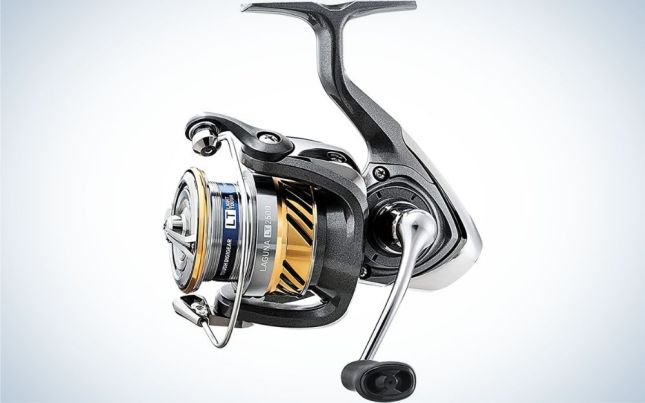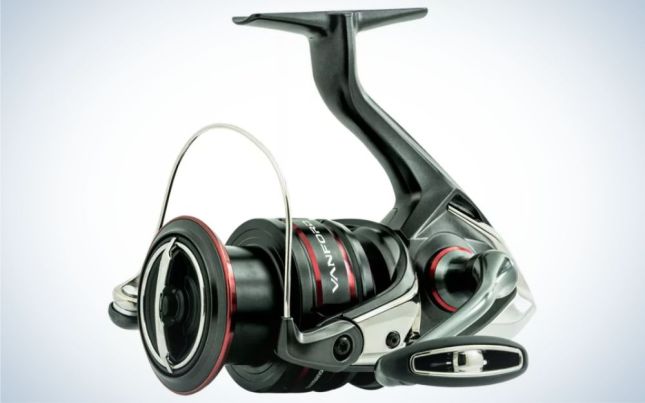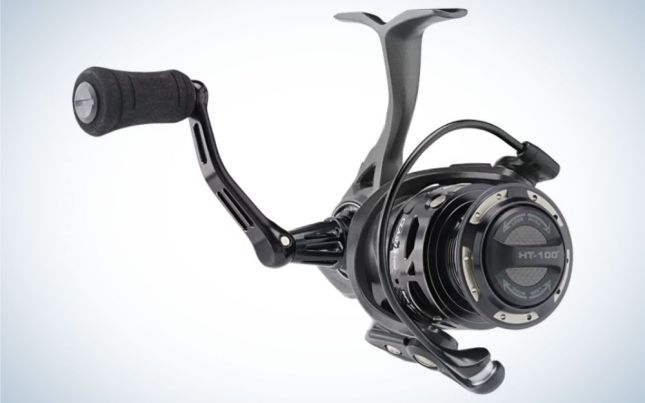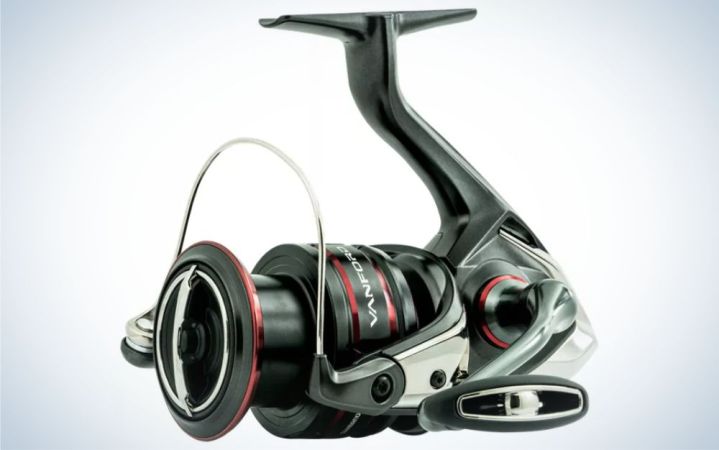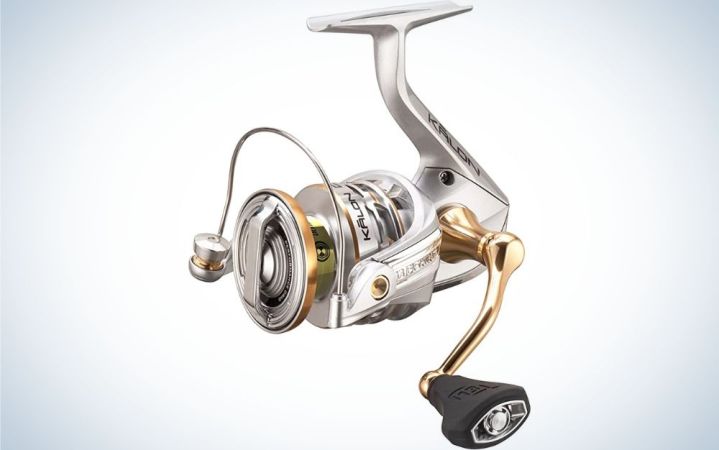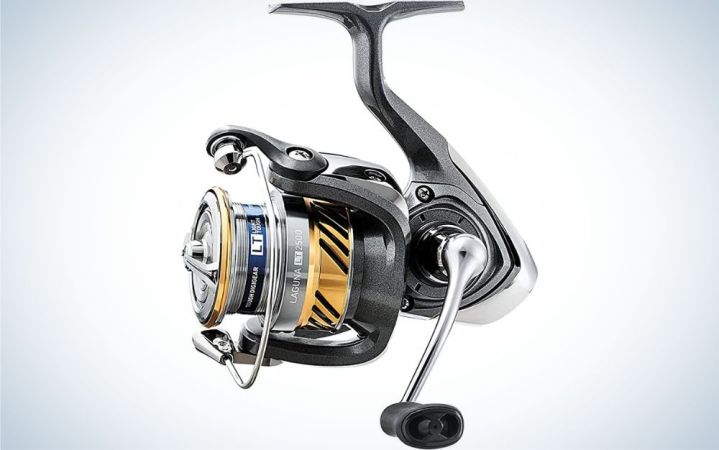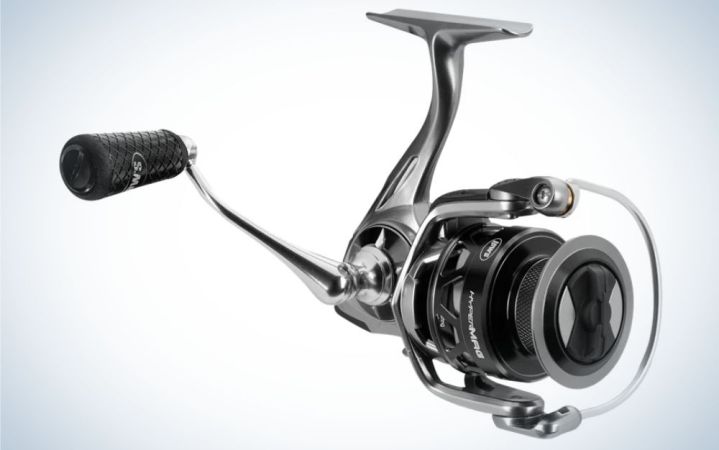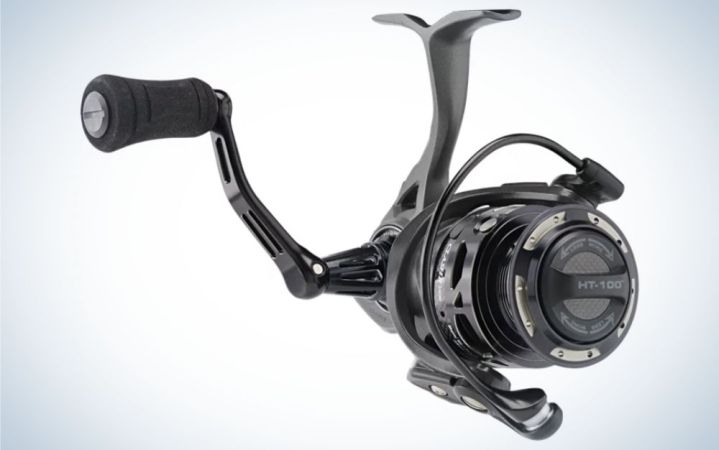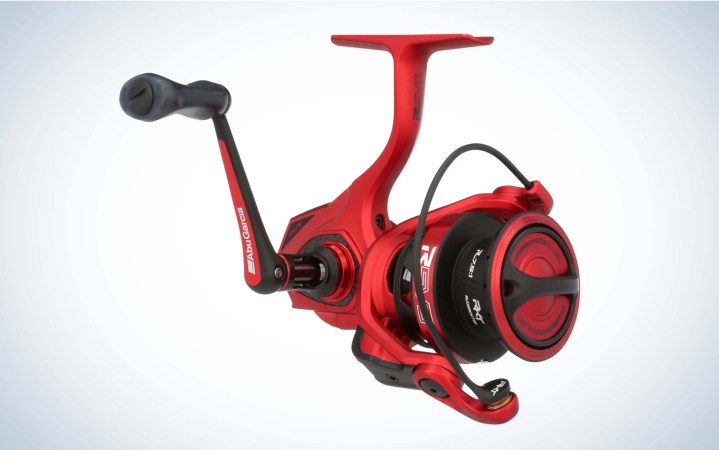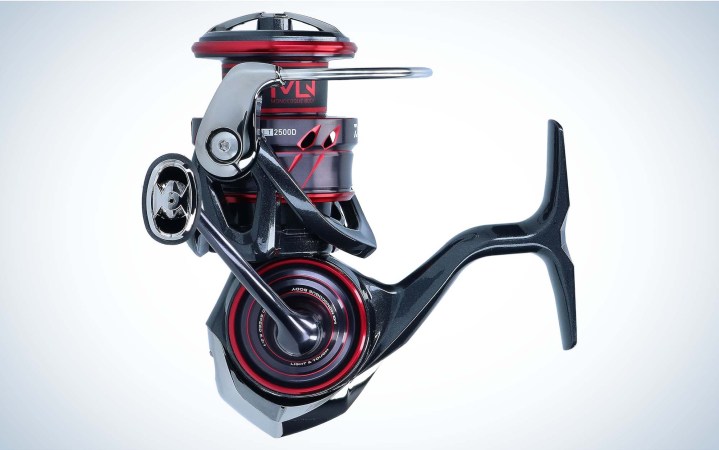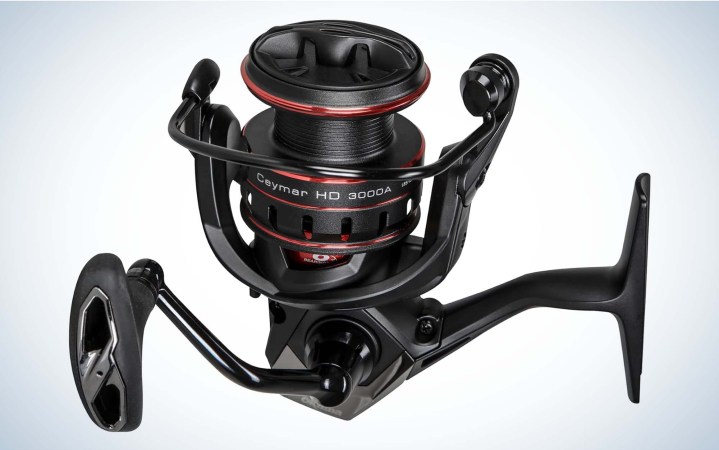We may earn revenue from the products available on this page and participate in affiliate programs. Learn More ›
Even the most stubborn, hard-core power bass fishermen have learned in recent years that spinning reels for bass have their place. They particularly excel for finesse techniques like dropshotting, Ned rigging, and wacky rigging, and their resistance to backlash means that they’re excellent for skipping under docks and overhanging brush.
Nevertheless, some bass anglers refuse to use anything but a baitcaster. That’s too bad, because modern spinning reels, especially but not exclusively the higher-end models, are functional works of art. They’ve reduced bugaboos like line twist while substantially improving drag systems and reducing overall weight.
My recognition of their value came while chasing rampaging yellowfin tuna in Panama and big salmon in Alaska—if the spinning reels can tame these beasts, there’s no reason they can’t be used effectively on a 4-pound smallmouth or 5-pound largemouth. Once I learned to tie an effective FG (fine grip) knot, I found I could spool my spinning reels with thin-diameter braid and top them off with a leader of ultra-premium fluorocarbon, giving me the best of both line types. Now I actually look forward to chasing big fish with an eggbeater reel. Here are my picks for the best spinning reels for bass:
- Best for Long Casts: Shimano Vanford VFC4000XGF
- Best Workhorse: 13 Kalon C 6.2-3.0
- Best Budget: Daiwa Laguna LT 2500
- Best High-Speed: Lew’s HyperMag HMS 300
- Best for Brackish Water: Penn Clash II 3000
- Best High Speed: Abu Garcia Revo Rocket
- Most Versatile: Daiwa Ballistic MQ LT 2500D
- Best Value: Okuma Ceymar HD 2500HA
How We Picked the Best Spinning Reels for Bass
I tested spinning reels over the past year on bass from Michigan to Mexico, as well as in saltwater, but mostly on the rivers of the mid-Atlantic. I’ve actually made it a point to try to integrate spinning tackle more consistently into my fishing, both to test its limits and because there are certain situations where it provides a distinct advantage over baitcasting gear. I find them especially effective when throwing the best smallmouth bass lures like a Ned rig. I spooled them with braid-to-fluorocarbon, straight fluorocarbon, and old-school monofilament to see if there were any performance differences.
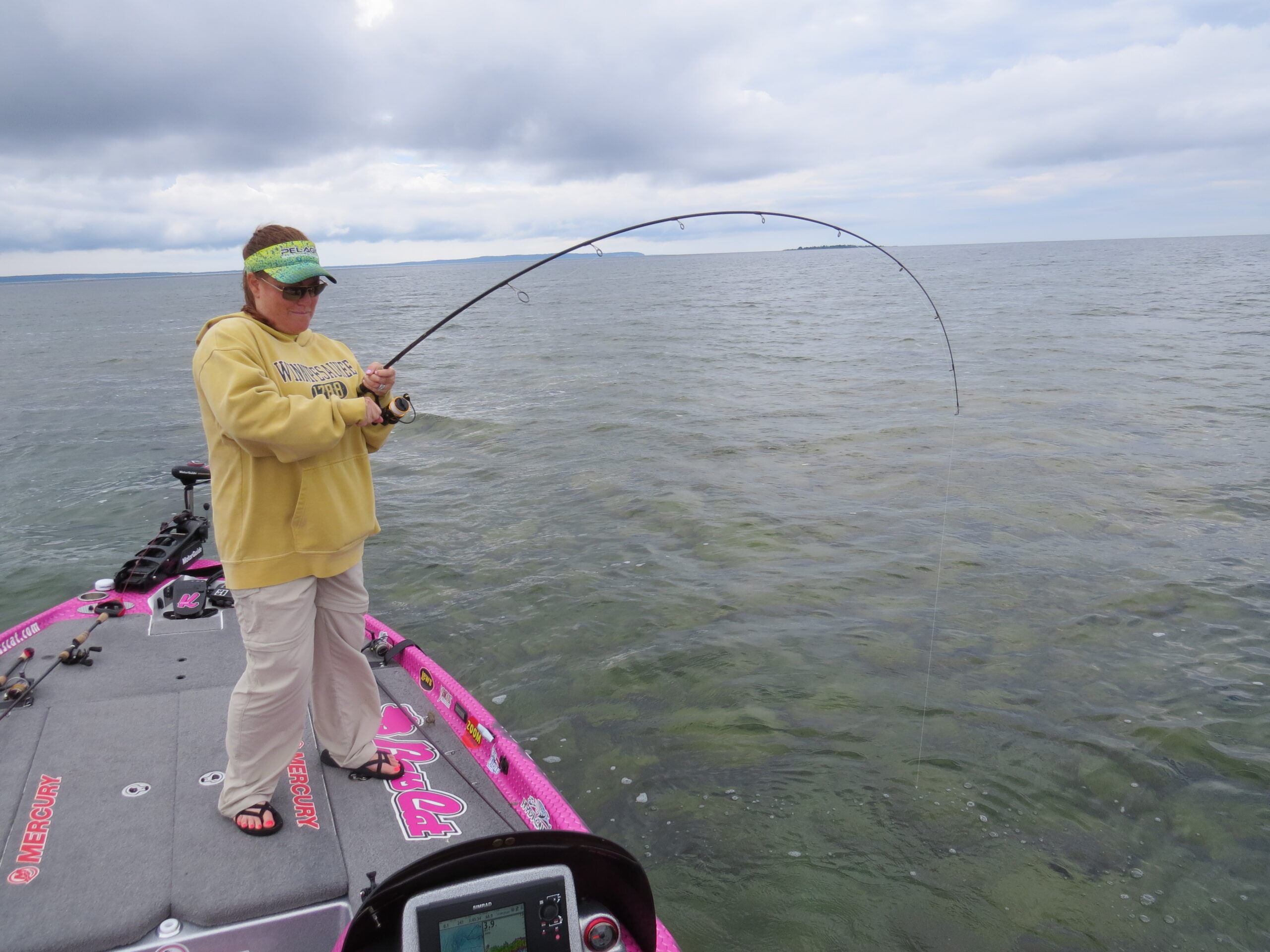
Best Spinning Reels for Bass: Reviews & Recommendations
Best for Long Casts: Shimano Vanford VFC4000XGF
Key Features
- 7.6 ounces
- 6.2:1 gear ratio
- Seven ball bearings plus one roller bearing
Pros
- Long-stroke spool for longer casts
- High-speed gear ratio
- Super-smooth
Cons
- Not quite as smooth as Shimano’s flagship reels, but at a fraction of the price
Shimano was one of the first brands to introduce ultra-premium spinning models like the Stella, but the cost put them out of reach of budget-conscious bass anglers. The Vanford steps into the gap between high-end and entry-level reels, with many of the features and performance of flagship models. I particularly like the Vanford in a 4000 size, which allows larger loops to come off the spool, yet it still weighs under 8 ounces, which means you can cast baits into the wind, or just bomb them with the prevailing breezes, and get longer casts than you ever thought possible. The line goes back on the reel tight and smooth, to continually enable longer and more precise casts. Even after taking a beating for a year, the Vanford still feels solid in the hand and ready for action. I never fear that it would fail or stutter and put even the most distant breaking bass within my range most of the time.
Best Workhorse: 13 Kalon C 6.2-3.0
Key Features
- 8.7 ounces
- 6.2:1 gear ratio
- Six ball bearings plus one roller bearing
Pros
- High-quality instant anti-reverse
- Speedy gear ratio
- Lots of bearings at a budget price
Cons
- Slightly heavier than some other reels in the survey
The expensive, high-tech spinning reels show their mettle from the start, and stay true consistently, but many of the reels at lower price points quickly lose their luster. Their tolerances become looser and the performance less crisp. Not this reel from relative newcomer 13. After a year of hard fishing—bouncing across rough lakes on the deck of my boat, and even being dropped into the drink—it continued to perform as if just out of the box with a minimum of care. That’s important, because while most of us claim we’ll baby our gear, we rarely do. The drag proved smooth when I latched into a giant unexpected catfish, and while the reel is a bit heavier than some of the others in this survey, it’s not oversized. If I was looking to get four or five spinning reels of the same model to build a complete arsenal, the Kalon might be the one I’d recommend.
Best Budget: Daiwa Laguna LT 2500
Key Features
- 8.8 ounces
- 5.3:1 gear ratio
- Three ball bearings plus one roller bearing
Pros
- A lot of bang for the buck
- Oversized handle knob easy to grab and hold
- True carbon frame is rigid yet not unreasonable heavy
Cons
- Heavier than comparable reels
Daiwa has packed features and quality into a spinning reel that retails for under $50 that would’ve been hard to find on models costing three or four times as much a generation ago. Now that the pros have access to lighter and smoother models, they might be disinclined to use a reel such as this one, but there’s no reason that they couldn’t. I found the drag to be reasonably smooth, the casts to be long and accurate, and the anti-reverse to be relatively solid and unforgiving. Moreover, if you just want to dip a toe into the spinning world, and you’re not sure whether you’ll be chasing bass, walleye, pike, or trout, this is a good choice to cover all of those bases. Keep one in your vehicle on a multi-piece rod for times when you pass a juicy looking piece of water and you’ll be glad you did—and not out much cash for the effort.
Best High-Speed: Lew’s HyperMag HMS 300
Key Features
- 7.6 ounces
- 6.2:1 gear ratio
- 10 ball bearings plus one roller bearing
Pros
- High-speed gear ratio
- Huge number of premium bearings at this price point
- Winn Dri-Tac knobs
Cons
- Limited sizes available
Historically, spinning reels’ line-retrieval rates were substantially slower than their baitcasting counterparts, and while they haven’t approached the 9:1 or 10:1 rate of high-end casters, they’re getting faster across the board. The Lew’s HyperMag excels when speed is of the essence—to corral a smallmouth running at the boat, or to bring in your popper for another cast at busting fish—not just because of its impressive gear ratio, but also because of all of its other features. For example, the Winn Dri-Tac knobs prevent you from losing your grip no matter how fast you’re reeling or what the conditions, and the 11 total bearings mean that the reel won’t break down after you put it through its paces. I love this reel for skipping a Senko, because I can get my lure back quickly on errant or unproductive casts and fire it back out. That means more total skips in the course of a day, and more fish over the course of a season. At the same time, I know that if I hook a true giant in gnarly cover, this reel will give its best fighting chance to help me get that fish in the boat.
Best for Brackish Water: Penn Clash II 3000
Key Features
- 10.1 ounces
- 6.2:1 gear ratio
- Eight stainless steel bearings plus one roller bearing
Pros
- Highly corrosion-resistant
- Proprietary CNC gear technology
- Super stout
Cons
- Relatively heavy
Anglers who want a reel that can manhandle big bass, pike, and catfish, but also excel in brackish water for species like redfish and stripers need a tool that won’t give out when exposed to salt air and salt water. Penn, a longtime leader in saltwater circles, makes a reel that’s fine for all heavy-duty saltwater applications, with the added benefit of corrosion resistance. A hydrophobic line roller bearing and the “Clutch Armor System” keep components working as intended for years to come, whether they’re subject to heavy spray or a full dunking. I took this one on the lower Potomac and sections of our other local brackish waters and then just hosed it down at the end of the day (OK, I might’ve missed a day or two). I’d love to take it to Central America for tuna or mahi and see if the drag system, which so far seems incredible, is in the neighborhood of those available on reels that cost two or three times more. Anglers can get this reel with either a paddle knob or a “power knob” depending on the type of fishing they expect to be doing and personal preferences.
Best High Speed: Abu Garcia Revo Rocket
Key Features
- Three Models: SP20, SP30, SP40
- All models sub-8 ounces
- 7.6:1 gear ratio
- Interchangeable left/right handle
- Nine stainless steel bearings plus one roller bearing
- Asymmetrical body shape
- Aluminum frame
- Oversized gear system
Pros
- Fast gear ratio is great for covering water or getting a bait out of an unproductive area
- Light
Cons
- Fast speed isn’t ideal for all presentations
The 7.6:1 gear ratio is a sweet spot for a wide range of techniques. Most of the spinning applications I utilize are presentations where the rod does most of the lure manipulation—dropshots, wacky worms, Ned Rigs. The goal is to get the lure out there into the strike zone, see if there’s a willing taker, and then get it back in for another cast. Obviously, in that case faster is better. When I fished with OL’s gear editor, Scott Einsmann, I had a bedding bass swipe at a soft plastic stick bait and mess up the rig. I got it back into the boat quickly, rerigged, and had the lure back in the sweet spot while the bass was still hot and bothered. Would I have been able to do that with a 6.2:1 reel? Possibly, but there’s no guarantee. The additional speed is a time-saver.
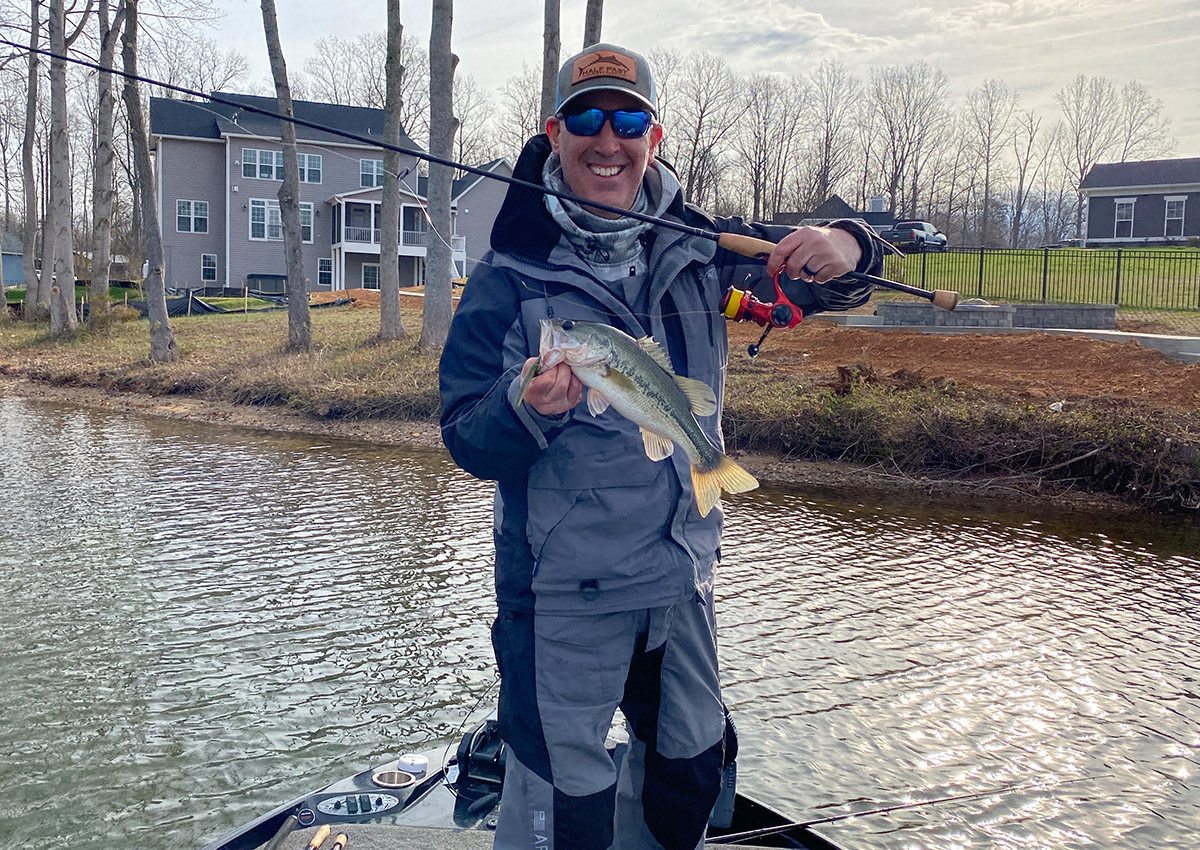
Obviously, it helps even more when you have a lot of line out, like dropshotting in 40 feet of water or making long casts with a shakey head on gently sloping points. If you’re making a lot of casts in a day, the cumulative savings should produce more fish over the course of a year—it’s not always discernible how many, but the savings exists. Furthermore, when a hard-charging fish comes directly at the boat, it enables the angler to make up ground quickly and keep the line taut, which prevents lost fish.
I’ve found that the fastest baitcasting reels—those in the 8:1 to 10:1 range—are simply too speedy for moving baits like spinnerbaits or crankbaits. But, 7.6:1 is still in a sweet spot where it can be used for those techniques. Just be careful not to overwork them. I’d be likely to use something slower in the cold weather months, when fish tend to be more lethargic.
With all of that speed, historically something has to give, usually cranking power or drag efficiency, but I winched decent-sized bass out from the deepest depths of boathouses, around pilings, and through brush without any slippage. Despite being light, this reel feels solid. Abu didn’t cut corners—the bail opens and closes securely, the handle has no wobble, and the spool oscillates cleanly on the retrieve.
Read the full Abu Garcia Revo Rocket Spinning Reel Review to learn more.
Most Versatile: Daiwa Ballistic MQ LT 2500D
Key Features
- Price: $229.99
- Gear Ratio: 5.2:1
- Weight: 6.9-Ounces
- Bearings: 2CRBB + 6BB + 1RB
- Line Capacity: 10/250 (Test/Yard)
- Drag Weight: 22-Pounds
Pros
- Incredibly smooth while reeling
- Castability
- A drag weight heavy enough to battle even the largest bass
Cons
- The gear ratio is a bit lower than other options, meaning a slower retrieve on the water
Throughout the summer of battling largemouth, smallmouth, lake trout, and even a 25-pound freshwater striped bass, the Daiwa Ballistic MQ LT’s high quality drag never slipped or failed. The quality of this reel can be felt with each turn of the handle, which fits perfectly in your hand with a well thought out handle design.
The author with a 25-pound freshwater striped bass he landed with the Daiwa Ballistic MQ LT 2500D.
Coming in at just below 7-ounces, you don’t have to worry about the weight of your reel wearing you down throughout a long day on the water. A final piece worth noting with this phenomenal reel is the castability. The first time I reared back and fired out a ¼-ounce swimbait head with a 3.8-inch soft plastic swimbait on the back, I was stunned at just how far along the bluff wall it went. It was almost like I was long lining the bait, but in reality, I had simply cast it out there.
If you’re looking for a high-quality reel at a very reasonable price, I wouldn’t look any further than the Daiwa Ballistic MQ LT 2500D. —Derek Horner
Best Value: Okuma Ceymar HD 2500HA
Key Features
- Price: $89.99
- Gear Ratio: 6.0:1
- Weight: 8.3-Ounces
- Bearings: 7BB + 1RB
- Line Capacity: 10/130 (Test/Yard)
- Drag Weight: 13-Pounds
Pros
- Very smooth while reeling
- Castability
- Deep spool for more line capacity
- High gear ratio for increased retrieve speed
Cons
- A fairly low drag weight
- At just over 8-ounces, it’s one of the heavier reels from the test
The Okuma Ceymar HD 2500HA might be the best value spinning reel for bass that I’ve seen in years. For just under $100, it offers anglers a quality reel at a more than fair price.
With such a low price point, you might assume the reel isn’t worth your time. That’s where you’d be wrong. While using the Ceymar HD throughout a season of fishing, I grew to love its castability and smooth feel while retrieving. The only negative piece I have is that the drag did slip once or twice under the load of some hefty lake trout making a run towards tree tops 80-feet below. It didn’t fail during that torture test, but it did bring forward an uneasy feeling in that moment.
Outside of the torture test, the reel performed flawlessly against 5-pound smallmouth in heavy current and big largemouth taking my dropshot for a ride. The Okuma Ceymar HD 2500HA punches above its weight class and is a great choice for anglers looking the most performance for their dollar. —Derek Horner
Things to Consider Before Buying the Best Spinning Reels for Bass
Drag
While some anglers continue to backreel or don’t ever find themselves in situations where a smooth drag is necessary, if you’re going to battle decent-sized fish on light tackle, you want clean and even slippage. It’s critical that the clutch start up without resistance and remain consistently smooth during the fight, especially in inclement weather. The most expensive reels typically have silky smooth drag systems, but it’s the mid-range and lower reels where there’s the greatest level of variation.
Spool Size and Line Capacity
While you’ll rarely get down to your spool knot when fighting a bass, a spool that’s too small typically won’t cast as far, because the loops coming off of it are smaller. That’s especially true if you’re using a heavier-diameter line. The line should flow off the spool with a minimum of resistance.
Weight
The premier reels of yesteryear are still functional, but they feel like anchors compared to the lightweight and more feature-laded models that dominate the shelves today. It’s now possible to retain rigidity and add features in a package that weighs less than your previous favorites. That should reduce fatigue over a long fishing day or trip. Often the best spinning rods don’t weigh much so you need a light reel to balance it because an unbalanced setup throws off your casting action or accuracy.
Read Next: The Best Bass Fishing Tips
FAQs
Most bass fishing techniques can best be accomplished with a spinning reel in the 2500 or 3000 size. That provides the best match of overall combo balance with line capacity. However, as reels get lighter, it may be possible to use a larger reel – in which the loops come off the spool in greater diameter – without any corresponding loss of balance.
Most spinning reels have gear ratios in the 5:1 to 6:1 range, and while faster speeds certainly excel for many techniques, these are more than adequate for most presentations you will make with spinning tackle. Remember that the number of inches of line picked up per revolution of the handle can be just as important as the gear ratio itself.
There’s no reason not to use a spinning reel for bass in any circumstances. Anglers who are most comfortable with this style reel can use it across the board. However, spinning reels particularly excel in light line, finesse techniques, and throwing lines lighter than 10-pound test. Because the line comes off the reel freely, they also excel for vertical techniques like dropshotting and shakey heads, where any “pendulum” action or resistance can be a huge negative.
Read Next: The Best Jerkbait Rods
Final Thoughts on the Best Spinning Reels for Bass
Some of the best bass lures should be fished on a spinning reel. If you want to take advantage of these highly effective techniques, choose the best spinning reels for bass that suits your budget and need.
- Best Overall: Abu Garcia Zenon 30
- Best for Long Casts: Shimano Vanford VFC4000XGF
- Best Workhorse: 13 Kalon C 6.2-3.0
- Best Budget: Daiwa Laguna LT 2500
- Best High-Speed: Lew’s HyperMag HMS 300
- Best for Brackish Water: Penn Clash II 3000

